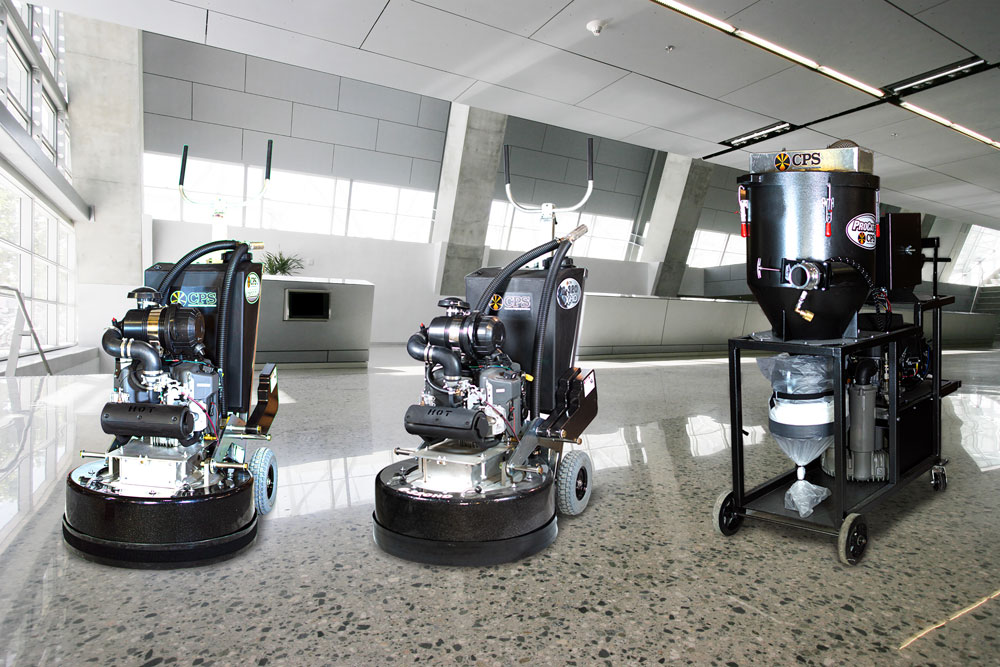Common Things to Avoid When Polishing Concrete

Polished concrete has appeared as a popular option for residential, commercial, and industrial spaces because these floors are easy to maintain and clean, as well as being affordable when compared to other flooring options. Polishing concrete floors is grinding a concrete floor multiple times with finer diamond grinding tools to remove any defects and flatten the floor’s surface and giving it a beautiful shine. Like any job, grinding and polishing concrete can easily go wrong, but we are here to prevent those mistakes from happening. Here are the common mistakes to avoid when polishing concrete.
Not Understanding Grinding and Polishing Stages
Grinding is a cutting stage, and polishing is a finishing stage after grinding. So, we grind concrete to cut it and polish the grind to reveal the finish. Understanding the difference is important because you will use different types of tooling and chemicals during the process.
Not Observing and Preparing the Floor
Contractors need to thoroughly inspect the floor for any obstructions like bolts or anything else sticking up from the concrete. Once those are taken care of it important to understand the condition and what type of repair work is required. For examples, are there cracks, do the joints need to be cleaned out and filled, does the concrete require a grout coat to fill in pin holes and help achieve a higher shine. All of these and more, are extremely important in achieving a good polished concrete floor.
Selecting the Incorrect Bond
If you select the incorrect bond for your job, diamonds do not work at 100% efficiency due to the heating up and glazing over the floor. It can also wear out the tooling too soon. The rule of thumb is that “soft concrete requires hard bond diamonds, and hard concrete needs soft bond diamonds”. Finding the right diamond tool to the concrete you’re working on is the key to achieving maximum productivity. There is a product called the Moh’s Hardness Test Kit that has picks with different elements for tips that are used to scratch concrete to determine the hardness of the concrete. This will then correspond to a chart telling you what CPS diamond tooling you should start with.
Choosing the Wrong Grinder/Polisher
Yes, all concrete floor grinders will do the job. However, choosing the right size and weight is crucial for achieving a good finish in a reasonable space of time. Also, some jobs require or will not allow certain types of grinders. For example, jobs might require you have a larger grinder due to time constraints or only allow propane equipment to be used.
Rushing the Grinding Process
Common mistakes contractors make is running the grinder at a very fast speed. When contactors run a grinder too fast, the speed can overheat and “glaze over” your diamonds, especially on hard concrete, which prevents them from cutting properly, or at all. Grinding too fast will result to having to go back over some areas multiple times. Also, moving too quickly at lower grits will “stretch” the scratch pattern and result in the need to go back over these areas later to fix issues. Patience is the tool to get the right floor outcome.
Not Removing Dust and Debris
Every job, dust control and debris removal are important. If you’re not removing dust and taking care of it before it reaches the breathing zone of nearby workers, can cause a range of health effects, mostly in the lungs. Causing a scar tissue build up in the lining of the lungs that contributes to serious, chronic lung problems. For industrial dust control. Use an industrial vacuum with a HEPA filter. These take 99.97% of the friable material of the air making it safe to work. Another option you might be interested in is to grind and polish concrete when it’s wet with water. Wet grinding will replace most of the airborne dust with a slurry that you can vacuum up with a wet vacuum and are encouraged to dispose of it according to local regulations.
Conclusion
Overall, polished concrete is an incredible floor choice due to simple and cost-effective maintenance among many other benefits. However, there are many variables to think about during the installation process that need to be focused on to achieve a truly, remarkable polished concrete floor. From choosing the right equipment, chemicals, and diamond tools to do the job right, to even understanding the history of the concrete and doing a thorough evaluation to prepare the floor during the early stages of the grinding and polishing process.

.jpeg)
.png)
